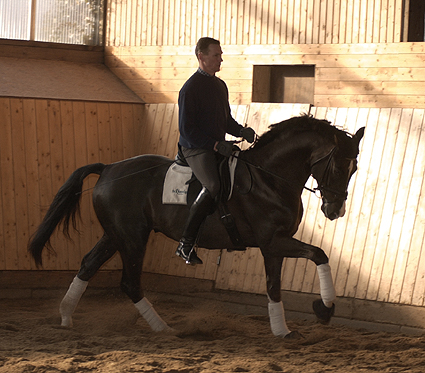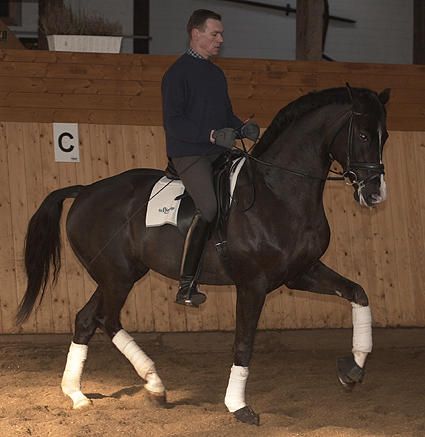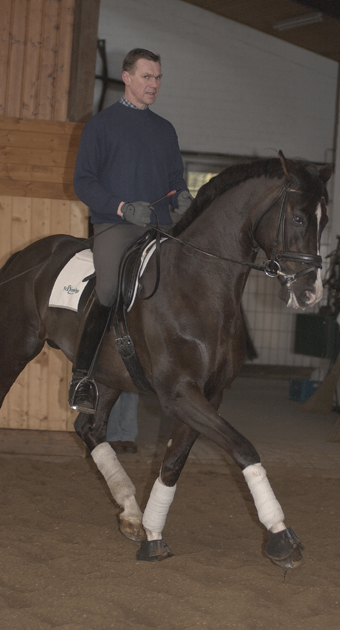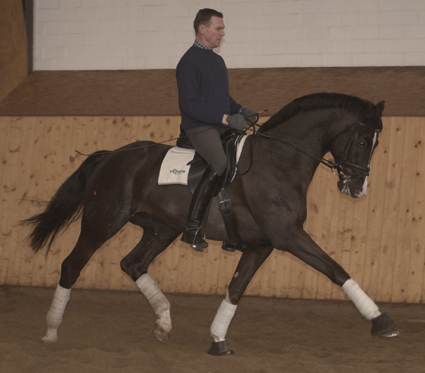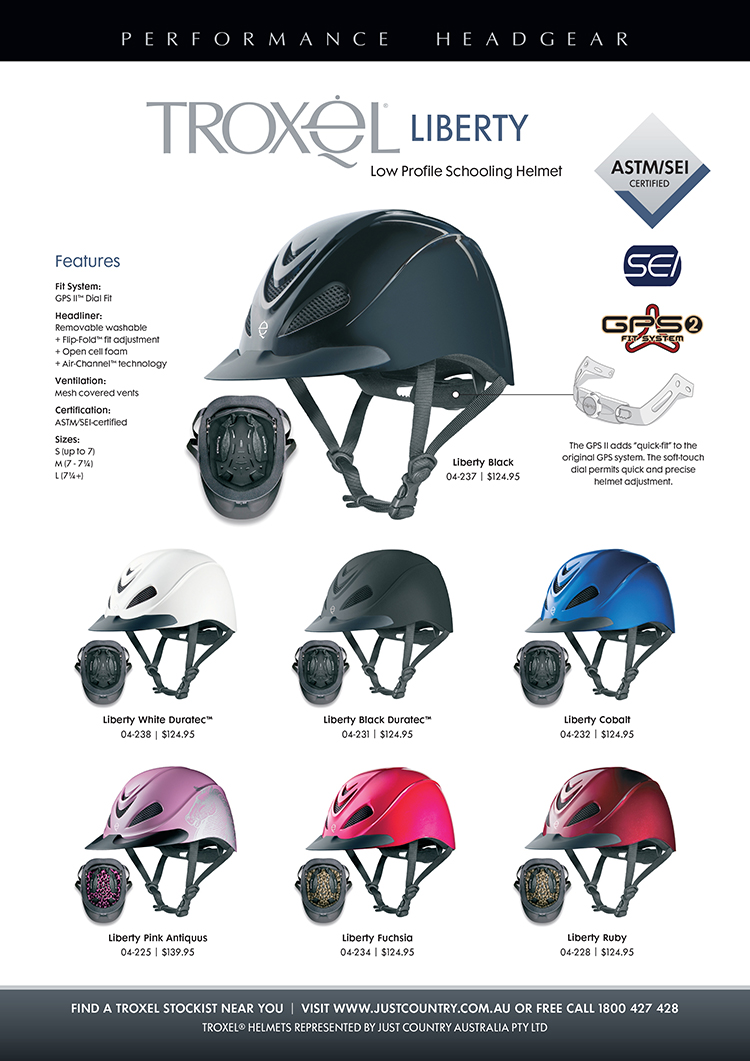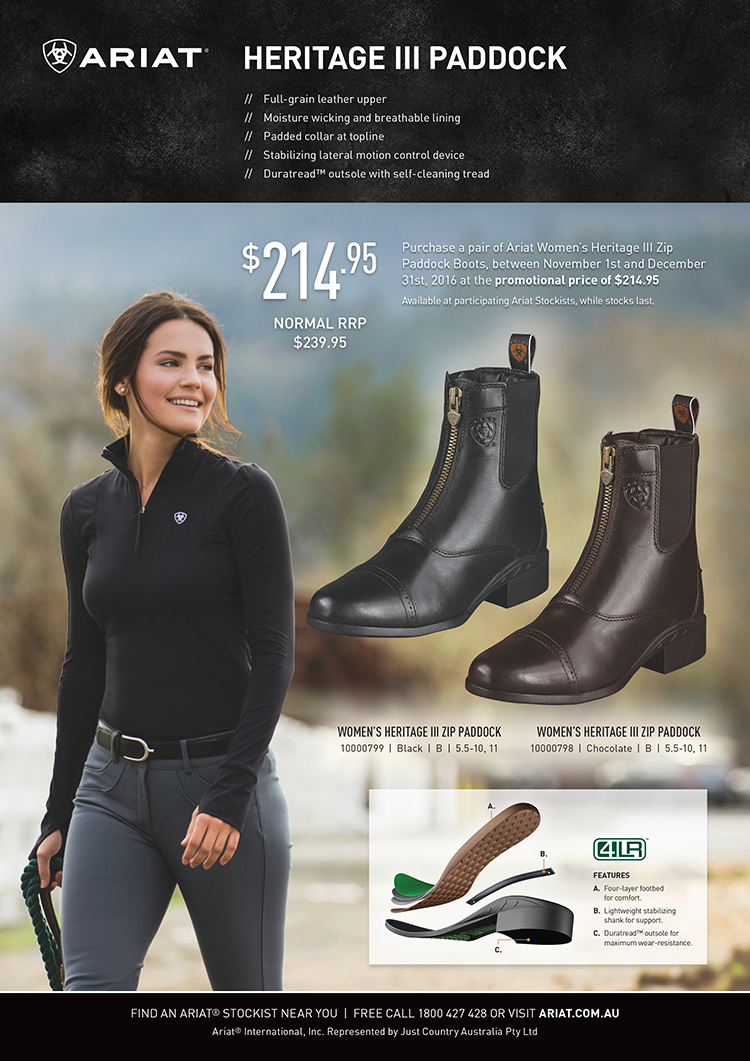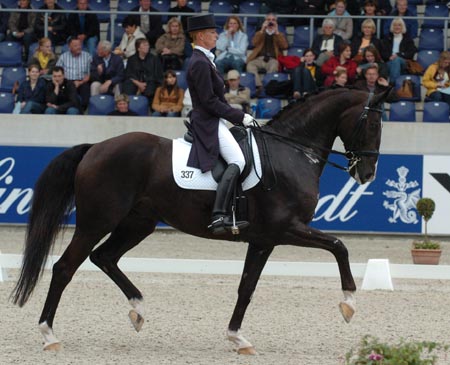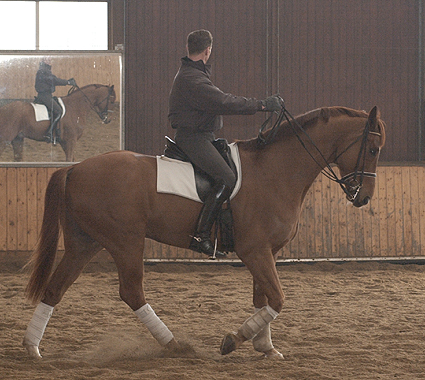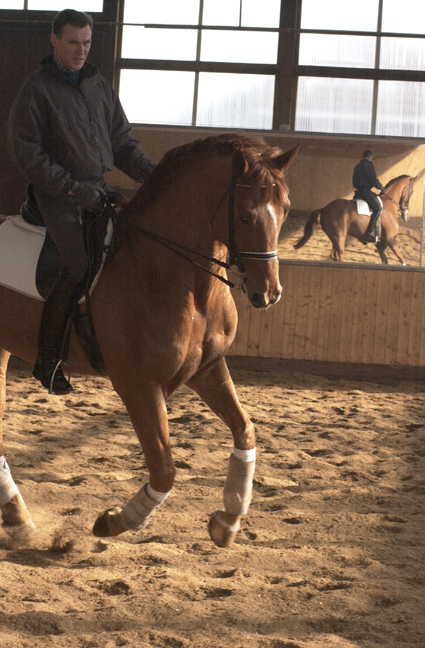I love the atmosphere at Holga Finken’s training stables. Everything is so professional, and all the horses are so forward, it is no wonder that Holga is regarded as the king of the young horse championships – the Bundeschampionate – but he is also building a growing reputation for producing very competitive FEI horses.
We’d gone to the school to watch Holga school my friend, Jens Meyer’s young stallion, Falsterbo.
When we’d last seen Falsterbo ridden by Jens’ wife, Suzy, the movement was very impressive – with Holga Finken in the saddle the movement is stunning. At last year’s Bundeschampionate in the three year old mare and gelding class, another Fidermark son, Fürst Fabio created a sensation with his extravagant yet ever-so-cadenced movement, Falsterbo has all that movement but is a much nicer type of horse (I suppose that is why Fürst Fabio is a gelding…).
Falsterbo had a wonderful canter with Suzy, but in the intervening six or so months, his walk has developed so much. It is now really big but still solidly four beat.
The trot is just awesome, so expansive, so stretched but still with that modern lift of the knee and freedom of the shoulder, and all the while he is tracking up right under himself behind.
But it is still the canter that blows you away, each stride comes up so extravagantly in front, almost climbing in the air, the distinctive front leg movement in the canter seems to be a real trademark of Fidermark, and you can see why good judges are saying that Falsterbo may well be the best son of Fidermark!
“Every rider wants to have a canter like this, but the problem is that a lot of riders forget that even with a canter as big as that, the important thing is how the horse goes over the back, that he sits, but at the same time he stays quick in the hindlegs. So you have the feeling that he is really round. You have to ride him forward, back, forward, back, so you build the power over time. The important thing is that he has to do this work every day, every day the same work, if you go a little bit too fast with the work, then you go back one step. The most important thing is every day basic work, you can’t ever say, ‘oh we have done that training now we can stop’. You must do it every day so that it becomes routine. The secret is that you ride the horses round, but at the same time over the back. When the horse is three or four you have to build up the strength so that the horse can hold this, you must have the horse on your seat, not on your hands. When they are on your seat, then you really have them, and they can carry you.”
“Suzy and Jens Meyer are really good with the horses, they are fantastic people, and Suzy has done a great job with Falsterbo,” Holga tells me later, “but he is a bit too much horse for her. So he came here. The horse has so much quality; the horse has to compete at L level at the Bundeschampionate because he is a five-year-old. Up until now he has just been doing stallion shows, just showing off his trot, now he has to go back to the basics, getting him really through so he can do the exercises of the L level test. Especially with this horse, the basic work is so important, he must go over the back, forward, downwards and through, then we can start on the movements – counter canter, half pirouettes in walk and so on.”
It’s not just the paces that impress; it is also the horse’s balance. An instant transition, walk to a counter canter strike off and effortlessly through the corner. Back to the same spot, walk to canter again, this time on the true lead and the young stallion is demonstrating an extraordinary ability to shorten the canter, without losing the length of stride.
Again according to Holga it comes back to the basics:
“The important thing is that the horse really goes over the back, forward into the hand and loose. Because I trained every day, trot walk, trot walk, then I can start with canter walk because he is always over the back, and loose in the body so it is no problem to him. He is really a very good horse at this level in the training scale. He will go L, he will go M. He can do changes now – he is very talented in these things.”
more below…
Holga is about to stop working on the flying changes…
“Now I will stop with the changes because the horse has to learn to go on the hind leg and really carry the counter canter. I know now he can handle the changes, and at the end of the show season, in December and January I will start again with the changes. I’ll stop now because he has to be so sure in counter and so strong that he can do it easily at the Bundeschampionate.”
Sure enough the horse drops out of the counter canter, and Holga quietly goes back, picks up the counter canter lead again, rides through the corner again, and gives the horse that big German pat on the shoulder that means ‘you got it right.’
There is a special straightness and balance with Holga’s horses. They are always in front of the aids, but at the same time listening to his seat so they are light in front. He is just playing with the most amazing nine year old I’ve ever seen, Roxino (by Rohdiamant, out of a Furioso mare, and that should be way too much French for a dressage horse but you don’t ride the sheets of paper).
The horse is so delicate, so light, and doing all the movements effortlessly. One times changes, a little passage, all with that glorious easiness and softness. Holga sets off and relaxes the gelding in a big free canter before working on the canter walk transitions, once more setting the horse back on its hind end, but still giving in front and building that movement and forward all the time…
“It is with all the horses from three year olds to Grand Prix, it is the basics that are the most important, that is the work you always go back to. If they can do Grand Prix exercises, I still go back to that basic work, bending, flexing. The most important thing is that they are over the back.”
There has been lots of discussion about the value of the Bundeschampionate as a guide to the future. There seem to be many bright stars that glitter at the young horse championships only to fade as fast as they have come. Some even disappear in the gap between the three and four year old material classes, and the five and six-year-old dressage classes. Holga sees these disappearances as the result of a whole host of factors: some rider/training error, some horse type and some plain old commercial influences…
“At the Bundeschampionate and the World Championships, you see horses in the final of the five year old class and then one year later, you can’t find these horses in the six year old class. Mostly it is because of the changes or the half passes, the horses can’t do those things, and mostly that is because the riders forget the basic work. They try more and more and only think about changes and half passes but they forget to go back to the basic work. Many riders forget this and that is why they can’t train the horses past the L level. Super horses, really high quality, but the riders forget this basic work, and that is why you can’t find the horses any more.”
more below…
Some of the horses just need a little more time…
“Sometimes horses can’t do the changes and suddenly when they are seven and eight, the horses are back again with super changes, and it was just that it took a longer time than other horses. It is always different with different horses, but it is mostly the basic work. From five to six is the most difficult jump for the horses because of the changes.”
“There are some horses that you see at the Bundeschampionate that only get a 7.5 or an 8 because they don’t have that special movement, but they are very good horses for Grand Prix. For the Bundeschampionate the most important thing is the movement – for the Grand Prix movement is also important, but you can have a horse that is not so good in the movement but it makes every letter perfect, and super piaffe passage, then you have a great horse for the Grand Prix but not for the Bundeschampionate, but it is very hard to explain this to the owners…”
“I try to keep the good horses here in my stable after the Bundeschampionate, but the problem is that it is also our job to sell horses. The owners say after the horse goes well at the Bundeschampionate, okay we can have a lot of money let’s sell. For example, Salinero with Anky van Grunsven, was here, and they came and bought the horse before he even went to the Bundeschampionate. There are many riders at the Bundeschampionate who are professionals and they sell the horses to riders who are not so good, and then you don’t hear of the horse again.
Anky and Salinero back in 2003, bought from Holga Finken’s stable…
Or some of the horses come to the Bundeschampionate ridden by their owners, and they can ride well up to L level, but after that, they are not the best rider for that horse for the higher levels. It is mostly a question of the rider. Many good horses are lost, and you never see them again, but most of the time it is because of the rider. Every horse needs its rider. There are many horses you never hear of, the are qualified and they are super horses, but they are sold. That’s life.”
Just to prove that there is life after the Bundeschampionate, into the arena came Wanesco, the big chestnut son of Weltmeyer who won both the five and six year old dressage classes, and is now entering an FEI career with Holga, already placing second at his first Prix St Georges at Bremen.
Once again, Holga shows that ability to have the horse entirely on his seat, as he rides around the arena, the horse still wearing its nice warm rug, he can easily stop the horse with the rein still slack. Rug off, down to business, and once again I am struck by the way Holga tends to start his working sessions in walk, and with quite a lot of lateral work at that. I know this might sound a little odd, but watching Holga work, I am continually reminded of the late Nuno Oliveira (odd since sadly for Nuno’s memory his loudest followers tend to present the essence of ‘backwards’ while Holga Finken is rightly regarded as the essence of ‘forward’). When they go to trot, the resemblance is maintained, Nuno was always one for getting the horse balanced and on its hindquarters in the trot, and Holga is doing much the same, gently stretching Wanesco in the trot, with the reins still slightly looped.
An absolutely square halt and they stand, and stand, and stand, and stand, and finally walk off and do another perfect square halt.
Again into that gentle trot, Holga sits a fraction of a second against the movement and the horses comes back a step and then goes gently forward again (how far is this from the crazy stereotype of the German trainer whipping and spurring while swinging off the double bridle?). Into some effortless half passes, another long long halt and into reinback, and Holga rides his horses up and forward into reinback better than anyone I know (Nuno who loved the reinback is smiling away up there in the écuyer’s heaven) and the big horse goes back in such a fabulous frame and it out into a huge effortless canter, silently caressing the ground as he touches down. Have you ever noticed that the amount of sound a horse makes has nothing to do with its size and shape? Then seamlessly into those big working pirouettes, and before that gets to be hard work, out and gunbarrel straight down the long side. Wanesco is late with the third of his two times changes, and Holga is quietly back, and does them again. Holga slips him into a three ones times changes and is out before the horse notices he was doing them, and out of the corner in that huge extended trot. The big trot has just emerged, no pressure, no hassle, just out of this oh-so-quiet working in.
Wanesco still finds the canter pirouette a little difficult and Holga keeps cool, slips out and into another a couple of strides away, that big slap on the shoulder one final time. The work is finished for the day.
Wanesco has been sold to the stud farm Sprehe, but luckily for us, Holga keeps the ride on him until the end of the year, hopefully, we’ll find ourselves sitting in the Finken family’s hall once again, watching this great combination tune, enjoying the horsemanship, of this most professional of training barns.




